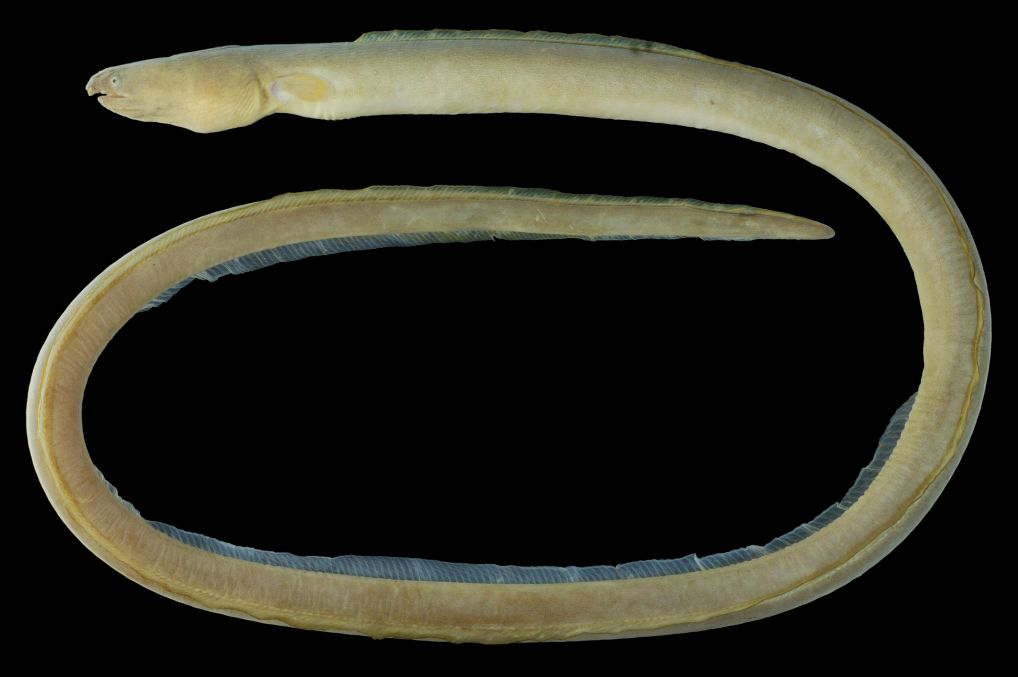Estuary Snake Eel, Pisodonophis boro (Hamilton-Buchanan 1822)
Other Names: Estuary Snake-eel, Rice-paddy Eel

Estuary Snake Eel, Pisodonophis boro. Source: Dinh D. Tran, FiMSeA / http://ffish.asia. License: CC by Attribution
Summary:
A slender cylindrical olive-brown snake eel with a paler underside, and the dorsal fin origin about one pectoral-fin length behind the pectoral-fin tip.
Cite this page as:
Bray, D.J. 2022, Pisodonophis boro in Fishes of Australia, accessed 03 Jul 2025, https://fishesofaustralia.net.au/Home/species/2907
Estuary Snake Eel, Pisodonophis boro (Hamilton-Buchanan 1822)
More Info
|
Distribution |
Dirk Hartog Island, Western Australia, to Vanderlin Island, Gulf of Carpentaria, Northern Territory. Elsewhere the species occurs in the tropical, Indo-west-central Pacific. Inhabits soft sediment areas in lagoons, estuaries and coastal marine waters; also enters freshwater and rice paddy fields. |
|
Features |
Vertebrae 167-170. Body slender, cylindrical, compressed only along extreme tail tip; anterior nostril tubular, posterior nostril along lower edge of lip; teeth granular to molariform, multiserial bands on jaws and vomer, but sharper on jaws and more pointed in juveniles; median fins not continuous posteriorly; extreme tip of tail stiff and finless; dorsal fin origin about a pectoral fin length behind tips of pectoral fins; lateral line inconspicuous. |
|
Etymology |
The specific name boro is a variety of rice, and the local name for this species in India, presumably in reference to the rice paddy habitat of this species. |
|
Species Citation |
Ophisurus boro Hamilton 1822, An account of the fishes found in the River Ganges and its branches: 20, 363. Type locality: Ganges estuary near Calcutta, India. |
|
Author |
Bray, D.J. 2022 |
|
Resources |
Estuary Snake Eel, Pisodonophis boro (Hamilton-Buchanan 1822)
References
Allen, G.R. 1997. Marine Fishes of Tropical Australia and South-east Asia. Perth : Western Australian Museum 292 pp. 106 pls.
Allen, G.R. & Swainston, R. 1988. The Marine Fishes of North-Western Australia. A field guide for anglers and divers. Perth, WA : Western Australian Museum vi 201 pp., 70 pls.
Chaudhry, S. 2010. Pisodonophis boro. The IUCN Red List of Threatened Species 2010: e.T166552A6234729. https://dx.doi.org/10.2305/IUCN.UK.2010-4.RLTS.T166552A6234729.en. Accessed on 10 January 2022.
Hamilton, F. 1822. An account of the fishes found in the River Ganges and its branches. Edinburgh : Archibald Constable 405 pp., pls 1-39.
Larson, H.K., Williams, R.S. & Hammer, M.P. 2013. An annotated checklist of the fishes of the Northern Territory, Australia. Zootaxa 3696(1): 1-293
McCosker, J.E. 1977. The osteology, classification, and relationships of the eel family Ophichthidae. Proceedings of the California Academy of Sciences 41(1): 1-123 figs 1-45
McCosker, J.E. & Castle, P.H.J. 1986. Family No. 42: Ophichthidae. pp. 176-186 in Smith, M.M. & Heemstra, P.C. (eds). Smith's Sea Fishes. Johannesburg : Macmillan South Africa xx + 1047 pp. 144 pls.
Smith, D.G. & McCosker, J.E. 1999. Family Ophichthidae. pp. 1662-1699 in Carpenter, K.E. & Niem, V.H. (eds). The Living Marine Resources of the Western Central Pacific. FAO Species Identification Guide for Fisheries Purposes. Rome : FAO Vol. 3 pp. 1397-2068.

